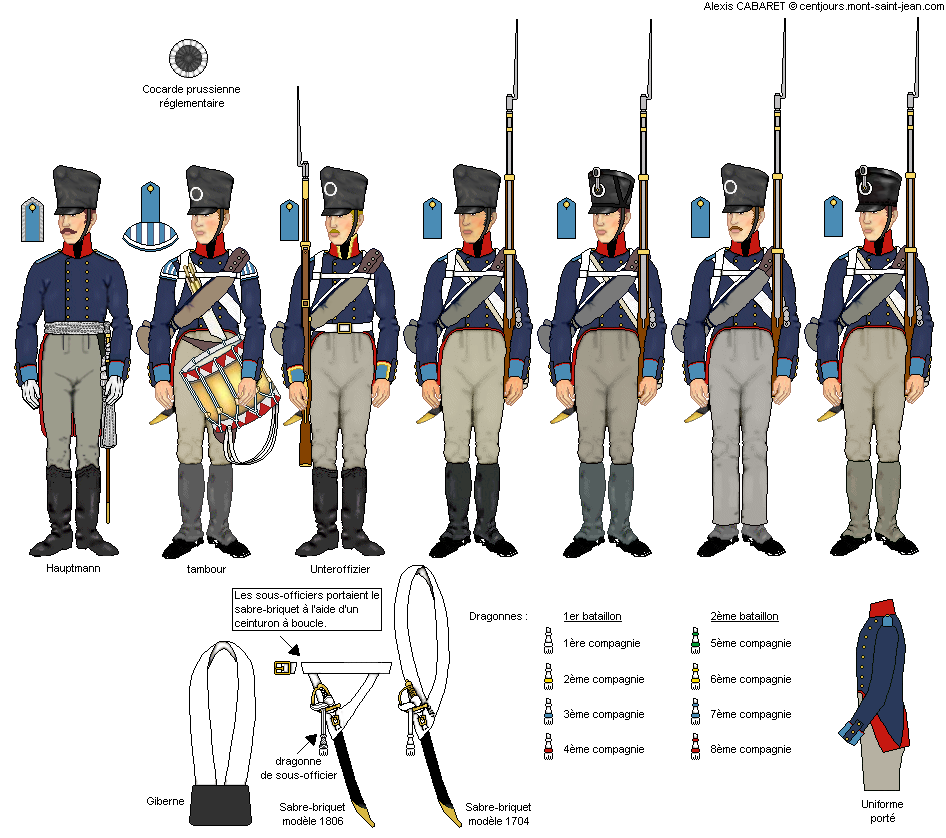Réponse définitive: tout le monde, y compris moi-même avait tort

Ni infanterie régulière, ni landwehr, mais légion étrangère

in Nafziger, Prussian Army of the Napoleonic wars , volume 2.
"
In February 1813 the King of Prussia spoke with his cabinet on the possibility of the raising of a battalion of foreigners. The actual authorization occurred with the issuance of the Order- in-Cabinet of 12 March 1813. The first soldiers were drawn together were organized into a "Freiwillige Jäger" detachment.
On 21 March the Russian General, Count Wittgenstein, the Military Governor in Berlin, directed that all foreign deserters should be drawn together in the Artillery Barracks #4. A total of 62 9 men were drawn together and organized there as a second foreign volunteer unit. This force was placed under the command of Oberstleutnant von Reuss. Von Reuss' first command was quickly organized into the "Russo-Westphalian Legion" on 30 March.
This second force was then absorbed into what was known as the "Russo-German Legion," a force consisting of 7 battalions, two cavalry regiments and three artillery batteries. The Russian Czar acted as the regimental "inhaber" or patron. This force was equipped by the British and operated with the Prussians.
On 7 April 1813 the Westphalian Legion had a total of twelve officers, twenty Unteroffiziere and 415 men.
On 20 April the battalion of foreign volunteers had nineteen officers, thirty Unteroffiziere, nineteen musicians and 436 men. The Russo-Westphalian Legion had four officers, two Portepeefähn- reich, four Junkers, four Feldwebel, twenty-eight Unteroffiziere, thirteen drummers and 660 men.
On 9 May Kapitain von Gotsch began forming the 2nd Foreign Volunteer Battalion. It was formed with the 200 excess men from the 1st Battalion of the Russo-Westphalian Legion and a further 200 men from the Hessian Guard and 90 from the Westphalian Che- vauleger-Garde-Regiment. This battalion was formally established by the King of Prussia on 28 May 1813.
On 5 July 1813 the King of Prussia directed that both battalions be formed into a new regiment, the Elbe Infantry Regiment. The theoretical strength of each battalion was forty-one officers, sixty Unteroffiziere, twelve musicians, 728 men, four surgeons and a battalion drum
The fusiliers and the third rank of the musketeers were taught to fight as skirmishers. The third rank was-drawn out of the companies and formed into a separate Zug. The other two ranks of the musketeers were to remain in line and fight in the old traditional manner. The infantry's principal formation was the "Angriffskolonne" or attack column.
The third battalion or fusilier battalion for the Elbe Infantry Regiment was organized by the Order-in-Cabinet of 21 July 1813. This battalion was raised from Pomeranian recruits.1 This was a decided contrast from the first two battalions. Those two battalions were trained soldiers of foreign origin. This new battalion was formed purely of new recruits. This third battalion wasn't mobilized until 6 October. The Order-in-
Cabinet of 2 September 1813 raised an ersatz battalion as a 4th Battalion for the Elbe Infantry Regiment by absorbing prisoners of war taken at the Battle of Dennewitz. These men were mostly Saxons. The battalion had a total strength of nine Unteroffiziere, six musicians and 336 soldiers. However, on 21 November the 4th Battalion was disbanded and its men distributed to the first three battalions.
In 1815 the Elbe Infantry Regiment was redesignated as the 1st Magdeburg Infantry Regiment No. 26.
The Elbe Infantry Regiment fought at Hagelberg (27 August 1813) and Dennewitz (6 September 1813).
The Elbe Infantry Regiment began its service in the uniform of the British light infantry. However, it soon adopted the Prussian uniform. The coat had a red collar and turnbacks. The cuffs were light blue and piped with red. The cuffs also had a dark blue cuff patch. It is known that the 4th Battalion had a blue jacket with green facings."
Gboue trop flemard pour tout vous traduire (z'aviez qu'à bosser vos cours d'anglais en classe

)

